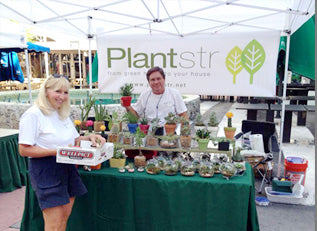Introducing Plantstr Watercolors – custom prints of your favorite Tillandsia Air Plants
As Tillandsia Air Plant lovers, we all look forward to “the bloom”. A time when our favorite air plants display their very best form – exquisite color and awesome flowers. Unfortunately, this is doesn't happen as often as we would like – and the blooms typically don’t last very long, which is one reason why we collect so many different varieties.
So, as an artist and designer, I started creating my Plantstr Watercolor Collection.






I’ve been able to capture the exquisite beauty of air plants at their peak of brilliance, and can now share that moment in watercolor prints in various sizes, either flat or framed, as well as canvas wrapped prints, note cards and other goodies for your home and office. These make memorable gifts for the Tillandsia lovers in your life.
You can place an order here (http://www.plantstr.net/collections/tillandsia-air-plant-watercolor-collection) for 8”x10” watercolor prints. These are individually printed on 300gsm Acid-Free, Cold Press Watercolor Paper.
Other sizes of Prints and Stretched Canvas Prints – with and without frames, as well as a great collection of customized goods and wearable’s can be purchased at: www.society6.com/plantstr.
PLEASE NOTE: Interior Designers- please contact me for additional sizes, finishes and framing options up to 30”x40”. Perfect for Restaurants, Hotels and Retail.
Les@Plantstr.net
Interesting Facts About Air Plants
Air plants are part of the Tillandsia family and they come from the tropics. The main cool fact about them is that they get their name from their capability of drawing all the nutrients and water that they need directly from the air (no soil is needed). Because of the way they feed, these plants can be hanged on fences, wires, or any structure you have indoors and outdoors. Some long arms that look like roots help these plants to attach themselves anywhere.
More than five hundred varieties of air plants exist in the world, spread naturally across Central America, West Indies and South America. These plants are different than regular plants because they don't have any typical roots, leaves or stems. The air plants can turn red and produce yellow-purple tubular flowers during the bloom cycle. In order to thrive, the plants need bright light from the sun, but the light needs to be diffused. In addition to misting once or twice a week, monthly soaking in water is beneficial for complete hydration. You can leave the plants to hydrate for a few minutes or for a few hours, depending on how much water they seem to need. Let them dry out before putting them back into your container.
For hydration, you should use bottled water or tap water from which the chemicals have evaporated over night. You will have to immerse the whole plant in water. The only type of water that shouldn't be used on air plants is distilled water, as it can kill them. Air plants are very popular today because they are beautiful, can live in any environment and don't occupy a lot of space.
The closest "relative" of air plants is the pineapple. You can find a lot of air plant varieties for sale today because they don’t need too much care and they can be combined with various decorative items.







 Plantstr is about making you feel good about yourself and the place you live. Beautiful, exotic flowering
Plantstr is about making you feel good about yourself and the place you live. Beautiful, exotic flowering 



